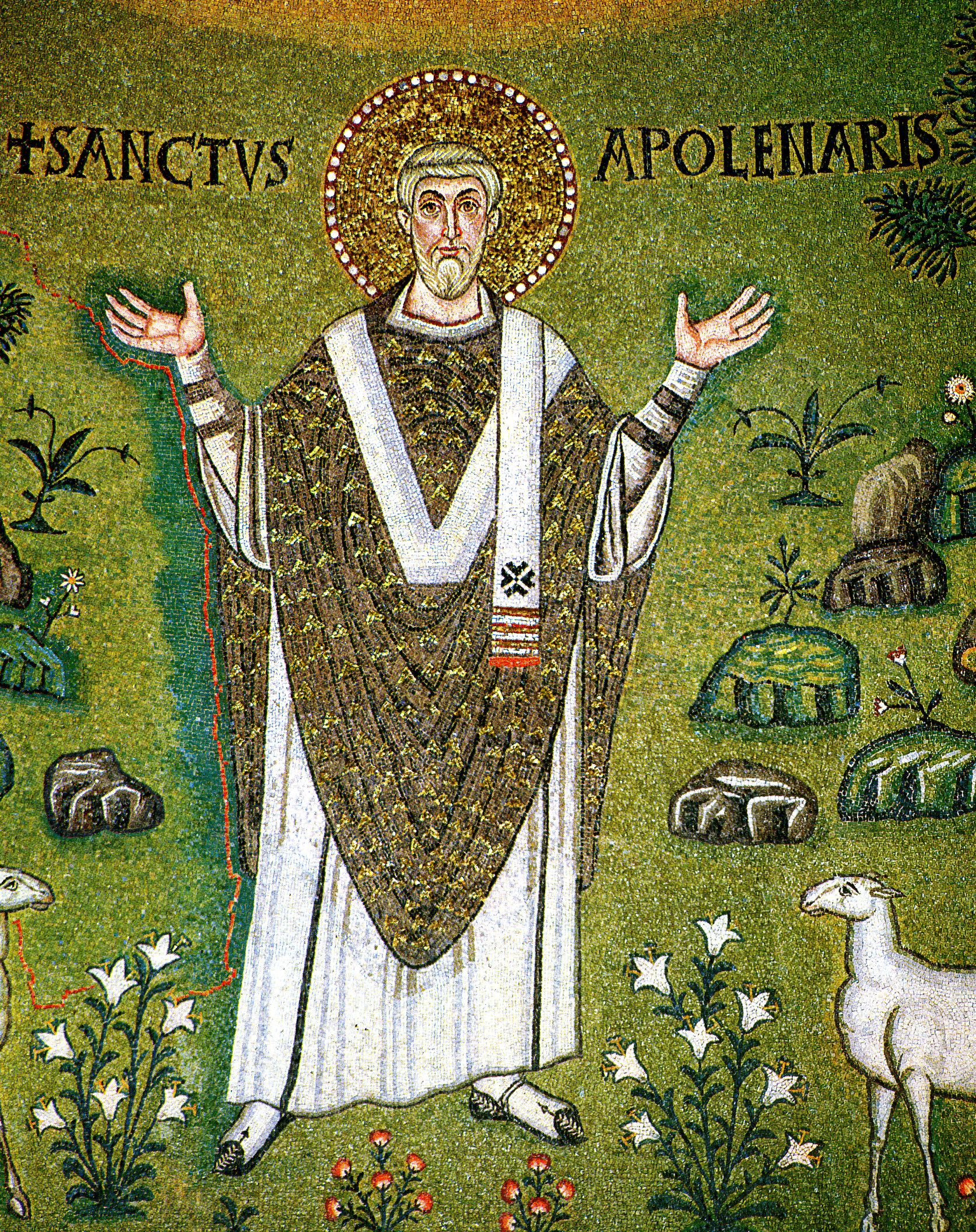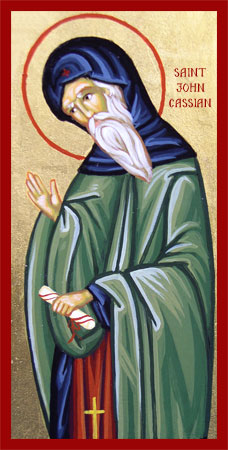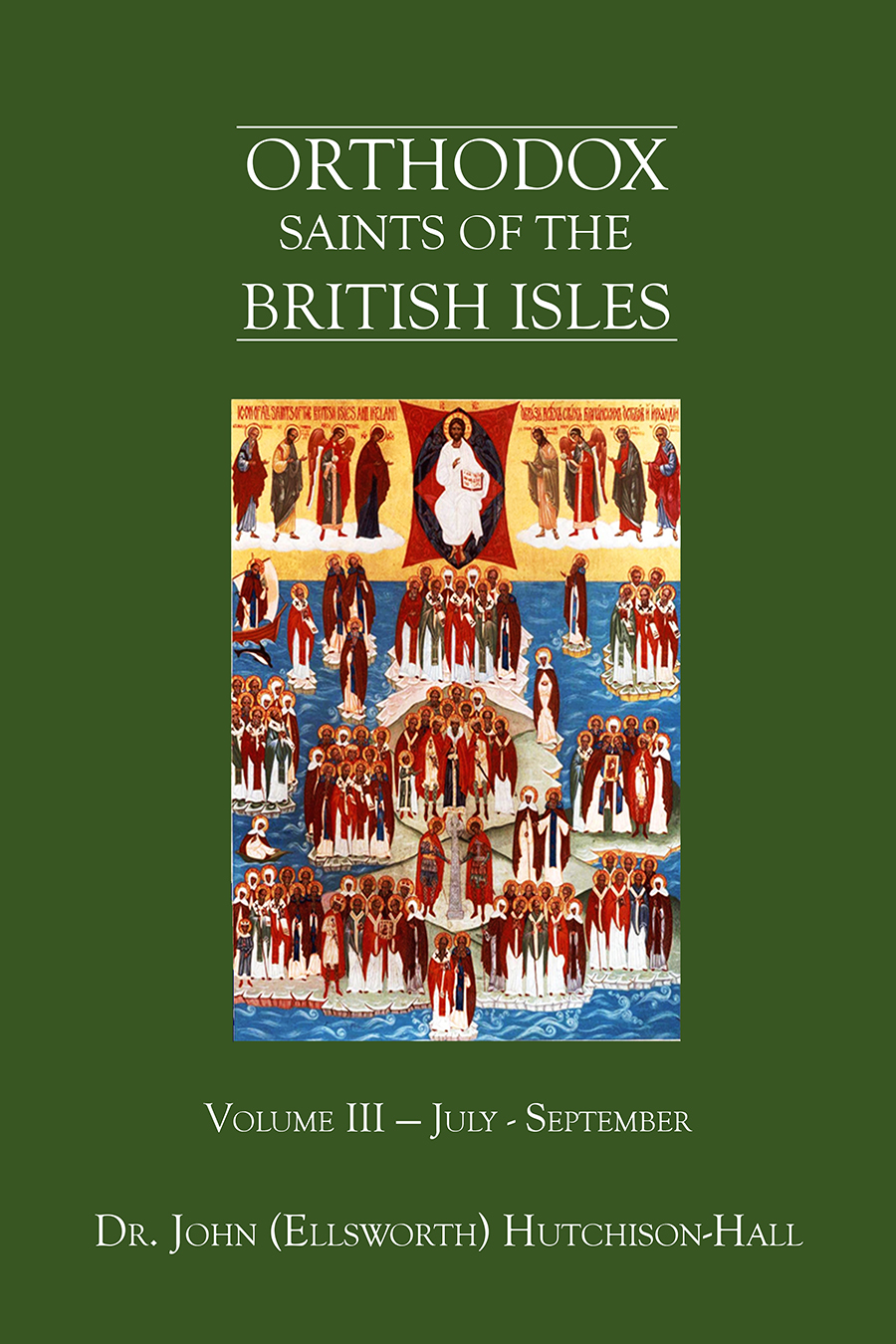
Orthodox Saints of the Pre-Schism
See of Rome
5th August (NS) — 23rd July (OS) 2023
APOLLINARIS of RAVENNA, (First Century), according to tradition, St. Apollinaris was a disciple of the St. Peter the Apostle (29th June), who consecrated him the first Bishop of Ravenna in Italy. He was also a noted wonderworker. St. Apollinaris served the people of Ravenna for twenty-six years, all the while being subjected to many cruel tortures for his refusal to renounce Christ. St. Apollinaris was martyred circa 79 at Ravenna, his relics are enshrined at the Abbey of St. Apollinaris in Classe, just outside of Ravenna.
APOLLONIUS and EUGENE of ROME, (Date Unknown), the metrical Calendar of Dijon mentions these two martyrs, who were sentenced to die for being Christians. St. Apollonius was tied to a stake, and he was then shot to death by arrows. St. Eugene is said to have dauntlessly placed his neck on the executioner's block. No further information on these saints is extant.
CONAN of CORNWALL, an early Bishop of Cornwall, England, St. Conan was appointed to the See by Æthelstan, King of England (r. 924–939). From the limited information extant it appears he was consecrated sometime between July 924 and 932, though 20th century British historian D. P. Kirby, is of the opinion that it is almost certain St. Conan was consecrated in 936. St. Conan served as bishop until his repose sometime between 946 or 953 and November 955.
JOHN CASSIAN, following an extended time amongst the monks in the deserts of Egypt, where he received monastic tonsure, St. John travelled to Marseilles (southern France). While on his way to Marseilles, St. John spent time studying under St. John Chrysostom, who ordained him to the Diaconate. Once in Marseilles St. John established the Abbeys of St. Victor for men, and Saint-Sauveur for women. However, St. John is undoubtedly best remembered for his writings especially the Conferences and Institutes, which were highly praised by St. Benedict (11th July). There is some debate as to the year of St. John Cassian’s repose, ranging from 434-435 to 440-458.
LIBORIUS of LE MANS, the second Bishop of Le Mans (north-western France) from 348 until his repose circa 390. St. Liborius is the patron saint of Paderborn, Germany where his relics were translated in 836, and enshrined in the Cathedral of SS. Maria, Liborius, and Kilian.
PRIMITIVA of ROME, beyond the her name and Rome as the location or her martyrdom, there is absolutely no information on St. Primitiva extant. It is also very possible this saint is the same as the St. Primitiva whose feast is commemorated on (24th February)
RASYPHUS and RAVENNUS of MACÉ, (Fifth Century), natives of Britain who fled their country during the Anglo-Saxon invasions, settling in Normandy (northern France) where they lived as anchorites. They were martyred in Macé, and their relics are enshrined in Bayeux.
RASYPHUS of ROME, (Date Unknown), a martyr of whom nothing is known, but has been venerated in Rome since time immemorial.
ROMULA, REDEMPTA, and HERUNDO of ROME, hermitesses in Rome. Their life of self-denial so affected Pope St. Gregory the Dialogist (3rd September) that he based one of his still extant sermons on them. SS. Romula, Redempta, and Herundo all reposed circa 580.
TROPHIMUS and THEOPHILUS of ROME, two martyrs in Rome during the Diocletianic Persecution, circa 302.
VALERIAN of CIMEIZ, a monk at the Abbey of Our Lady of Lérins (abbaye Notre Dame de Lérins) on one of the Lérins Islands in the Mediterranean Ocean off the Côte d’Azur in France. who served as Bishop of Cimeiz (part of present-day Nice France) in the middle of the fifth century. The exact dates St. Valerian served as bishop are unknown, however, he is listed amongst the attendees at the Councils of Riez in 439 and Vaison in 442. St. Valerian reposed circa 460.
Get your copy of Orthodox Saints of the British Isles today.
Available at Amazon or your favourite e-bookstore.
ABEL of REIMS, a monk from the British Isles, most likely Ireland. There are several accounts of his episcopal service. In one he was Archbishop of Reims (north-eastern France) circa 744-748, but seems to actually only served as a Suffragan Bishop of that See. In the another, he is elevated to the Archbishopric of Reims, however, he was unable to assume the throne, as it was occupied by supporters of a pretender bishop of that See. This was a time of struggle between secular and church authorities and often influential laymen obtained the office of archbishop for their own, worldly benefit. And so, St. Abel took up residence at (or possibly returned to) the Abbey of St. Peter of Lobbes (abbaye Saint-Pierre de Lobbes — Hainaut, Belgium), eventually serving as Abbot, and reposed circa 751.
AFRA of AUGSBURG, a martyr in Augsburg, Bavaria (Germany) circa 304, probably during the Diocletianic Persecution. As with many early saints, there are questions regarding the historical accuracy of her life, as there is no mention of her in martyrologies until the fifth century. Her relics are enshrined in the Church of St. Afra, a part of the Kloster Sankt Ulrich und Afra Augsburg.
CASSIAN of AUTUN, the fifth Bishop of Autun, Burgundy (France) from circa 314 until his repose circa 350. He may have been Egyptian by birth, but had come to Autun and was a disciple of his predecessor as bishop, St. Rheticus of Autun (20th July).
EMYGDIUS (EMIDIUS) of ASCOLI PICENO, a bishop in Ascoli Piceno in the Marches (central Italy). According to tradition St. Emygdius was martyred circa 303 during the Diocletianic Persecution.
GORMCAL (GORMEAL, GORMGALL) of ARDOILEÁN, St. Gormcal was Abbot of a monastery at Ardoileán (Ard Oileán) in Co. Galway, Ireland, and a participant in the monastic revival of his era. He reposed in 1016.
MARTYRS of ROME, a group of twenty-three who were martyred circa 303 whilst in prayer during the Diocletianic Persecution.
MEMMIUS (MENGE, MEINGE) of CHÂLONS-SUR-MARNE, according to tradition, St. Memmius was the founder and first Bishop of Châlons-sur-Marne (present-day Châlons-en-Champagne north-eastern France). St. Memmius reposed circa 300.
OSWALD of NORTHUMBRIA, the holy, glorious, right-victorious martyr and right-believing Oswald, King of Northumbria (r. 634–641/2). Following the death of his father in battle St. Oswald’s mother fled with her children into exile in Scotland and it is believed that during that time he was baptised at Iona and also learned Gaelic. In 634 St. Oswald assembled an army and prepared to meet that of Penda and Cædwalla at Hatfield Chase near present-day Doncaster, South Yorkshire. Although most of his men were not Christians, St. Oswald had a great wooden cross erected on the field, steadying it with his own hands as his men filled the hole that had been dug for its base. He then ordered his army to kneel and pray to the true and living God that He grant them victory:
"Let us now kneel down and pray to the omnipotent and only true God, that He will mercifully defend us from our proud enemy,” he told them, “for He knows that we fight in a just war in defence of our lives and our country.”
Later that night, St. Oswald had a vision of St. Columba of Iona (9th June), who stretched his cloak over the sleeping soldiers and promised that St. Oswald’s army would be victorious in battle the next day. St. Oswald’s forces prevailed at Hatfield Chase and St. Oswald established his supremacy over Northumbria.
One year, as St. Oswald was about to sit down to his Easter meal with St. Áedán of Lindisfarne, a servant came in and informed the king that a large number of poor subjects were outside begging for alms. St. Oswald ordered that his own food be served to the people on silver platters, and furthermore that the platters should then be broken up and the silver pieces be distributed amongst them. This act so moved St. Áedán that he took St. Oswald’s right hand and said, “May this hand never perish”. And, according to tradition, St. Oswald’s hand remained incorrupt for centuries.
For the next half decade Britain experienced a rare period of stability, and while tending to the temporal matters of his realm, St. Oswald also laboured to bring spiritual enlightenment to his people. Approaching the Celtic monks at Iona, rather than the Roman clerics at Canterbury, St. Oswald invited missionaries to preach the Gospel to his people. Unfortunately, the first bishop sent on this mission was too harsh, and alienated more people than he attracted and was soon recalled. St. Áedán of Lindisfarne (31st August) was then consecrated bishop and dispatched as the new hierarch. He proved to be the ideal choice, and St. Oswald gave him the island of Lindisfarne for his See. There St. Áedán founded the famous Lindisfarne monastery where many future saints were trained. As St. Áedán was not yet fluent in the Anglo-Saxon language, St. Oswald would often accompany him on his missionary trips to act as interpreter, and thus through word and example, people were drawn to Christ.
St. Oswald was often seen sitting in prayer; he gave land and money for the establishment of monasteries, and was renowned for his charity and generosity to the poor.
St. Oswald fell in the Battle of Maserfield on 5th August, 642 at the age of thirty-eight. As he died, he prayed for the souls of his soldiers saying, “O God, be merciful to their souls”. Following his repose St. Oswald’s body was dismembered and his head and arms displayed on poles. Many miraculous healings have been attributed to his relics and the earth from the site where St. Oswald fell, and it is said a plague in Sussex was averted by Oswald’s intercession. According to the distinguished twelfth century English historian, man of letters, and monk, William of Malmesbury (†c. 1142), St. Oswald is the first English saint whose relics worked miracles.
A year after his martyrdom, St. Oswald’s head was enshrined at Lindisfarne and portions of his relics were distributed to churches in England and on the Continent. Today, St. Oswald’s head is enshrined in St. Cuthbert’s coffin at the Cathedral Church of Christ, Blessed Mary the Virgin and St Cuthbert of Durham, at Durham England; unfortunately, the rest of his relics seem to have been lost. The translations of St. Oswald’s relics is commemorated on 20th June.
Troparion of King St. Oswald
Tone II
Mighty works did the holy King Oswald accomplish for the Faith,
for in his great and surpassing love he willingly laid down his life for the people of God;
wherefore, the Christ God filled his sacred relics with mighty power,
to heal the sick and move men’s souls to compunction.
Troparion of King St. Oswald
Tone V
Example to kings, champion of the Faith and missionary of God’s Holy Word,
thou didst excel in spiritual virtues O Father Oswald.
With Áedán’s help thou didst lift from Northumbria the heavy yoke of heathenism and fearing nothing,
thou didst confront the forces of darkness, thereby exchanging thy earthly crown for the crown of martyrdom.
We who are blessed to have thy precious relics with us to this day
entreat thee for thy prayers that Christ our God will grant us His great mercy
PARIS of TEANO, beyond having been the Apostle and first Bishop of Teano in Campania Italy, all that is known about St. Paris is legend. He is thought to have been of Greek origin and consecrated bishop by Pope St. Sylvester I (31st December.
THEODORIC of CAMBRAI-ARRAS, Bishop of Cambrai-Arras in the present-day Nord-Pas-de-Calais region of France. He served that See from circa 830 until his repose in 863.
VENANTIUS of VIVIERS, (Sixth Century), a Bishop of Viviers (southern France), though the date and place of birth and death unknown. it is recorded that he attended synods at Epaon in Burgundy (east-central France) in 517 and at Clermont (central France) in 535.
Prior to the Schism the Patriarchate of Rome was Orthodox, and fully in communion with the Orthodox Church. As Saint John of Shanghai and San Francisco +1966 said “The West was Orthodox for a thousand years, and her venerable Liturgy is far older than any of her heresies”.
Details of British Saints excerpted from Orthodox Saints of the British Isles.
Details of continental saints from these sources.
In many cases there are several spelling versions of the names of saints from the British Isles. I use the Oxford Dictionary of National Biography version as the primary version with the more prevalent version in parenthesis e.g. Ceadda (Chad) of Lichfield.




